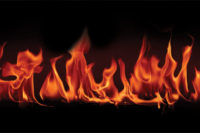The components or materials allowed in a tested fire resistive design are limited to those elements specifically identified in the description of the tested design. Substituting, omitting, or adding elements to those described for a tested design is prohibited unless specifically approved by the testing agency.
Substitutions
Where the word “proprietary” appears in design descriptions, either the design or one or more of its components are considered proprietary. Each proprietary system shall be built utilizing the components specified by the company or companies listed under the detailed description for that system.
For example: UL Design V438 is a “proprietary” interior wall partition consisting of light gauge metal framing members with mineral fiber insulation and one layer of 5/8-inch type X drywall on each side. The proprietary product is the 5/8-inch type X drywall produced by National Gypsum Co. and no other drywall product, unless specifically approved by inclusion in the test narrative, may be used with this assembly. The other elements, metal studs, insulation, joint compounds, fasteners, etc., are not proprietary products and may be provided by a variety of manufacturers, provided the products meet the requirements of the test and appropriate standards. For example, the floor and ceiling runners must be channel shaped, fabricated from minimum 25 MSG corrosion-protected steel, minimum width to accommodate stud size, with minimum 1¼-inch long legs, attached to floor and ceiling with fasteners 24 inches o.c. maximum or as otherwise noted in the assembly narrative.
Omissions
Tested fire resistive designs describe all of the elements that are required for that assembly and the manner in which those elements are to be installed. Omitting any single element that is described for the design or the manner in which it is to be installed will invalidate the stated performance. For example, one of the elements of UL Design V438 is a layer of drywall on each side of the partition. It is obvious that by not providing one of the layers of drywall, the assembly will not perform as designed, but the omission of an element such as insulation may also affect the designed performance. Regardless of how insignificant an element may seem, unless the design states that an element is “optional” it must be included in the assembly.
Additions
Adding elements not specifically identified in the design may adversely affect the performance of the design, and unless elements are listed as “optional” in the assembly or specifically permitted by UL and/or Gypsum Association, they may not be arbitrarily applied to the design. For example, UL and GA allow the substitution of screws for nail fasteners: “Screws meeting ASTM C1002 shall be permitted to be substituted for the prescribed nails, one for one, when the length and head diameter of the screws equal or exceed those of the nails specified in the tested systems and the screw spacing does not exceed the spacing specified for the nails in the tested systems.” Although screw and nails may be substituted, UL and GA do not permit the use of adhesives as a substitute for screws or nails in a fire tested assembly. Unless adhesives are specifically addressed in the design as either a mandatory element or an optional element, they are not permitted to be added to the tested assembly, for whatever reason.
If the documents specify a specific assembly you must comply with the requirements of that assembly. If you wish to substitute for a proprietary product identified in the assembly, consider requesting an alternative design that permits the products you would prefer and that achieves the same performance as the assembly specified in the documents.






Report Abusive Comment